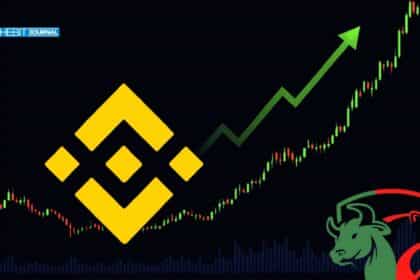Ethereum’s co-founder, Vitalik Buterin, has once again stirred the developer and investor communities with a technical proposal. Buterin introduced the idea of transitioning Ethereum’s execution layer from the Ethereum EVM (Ethereum Virtual Machine) to the RISC-V instruction set.
While the market hasn’t reacted with immediate price movement, ETH stands at $1,625 at press time. The scalability, efficiency, and developer traction are fueling growing discussions about whether Ethereum is preparing for a bullish move.
Vitalik Buterin’s RISC-V Pivot: What It Means for Ethereum
In a detailed post on the Ethereum Magicians forum, Buterin laid out a roadmap for replacing the legacy Ethereum EVM bytecode with RISC-V, an open-source, extensible architecture commonly used in modern computing systems.
Buterin argued that this would streamline Ethereum’s execution model and unlock dramatic improvements in zero-knowledge proof (ZK) computations, potentially improving performance by 50x to 100x. These enhancements could lower transaction costs, accelerate Layer 2 development, and make Ethereum a more developer-friendly platform without abandoning existing tools like Solidity or Vyper.
“The transition would reduce code complexity, preserve compatibility with legacy smart contracts, and significantly accelerate ZK proving systems, which are central to Ethereum’s long-term scalability,” Buterin wrote.
This isn’t Ethereum’s first bold reengineering attempt. Past changes like EIP-3855 (PUSH0 opcode) or the SELFDESTRUCT removal faced delays due to edge case issues. And while the RISC-V upgrade would represent a clean break from the Ethereum EVM’s previous constraints, it also introduces implementation risks that could delay or complicate deployment across Ethereum’s mainnet and L2 rollups.

Ethereum Market Stalls as Traders Await Confirmation
Despite the high-tech promise, Ethereum’s price action remains muted. As of April 22, ETH is trading just above $1,600, a level it has struggled to hold in recent weeks amid broader macroeconomic uncertainty and declining on-chain activity.
According to Token Terminal, Ethereum’s daily transaction fees have fallen to Q1 2024 levels, prompting questions about demand elasticity for ETH as gas. Santiment data shows social dominance for Ethereum has dropped to a four-month low, even as anticipation for the May 7 “Pectra” upgrade continues to build.
Why Traders Should Watch the RISC-V Transition Closely
While the proposal may seem abstract or distant, its potential implications are very real. The long-standing reliance on the Ethereum EVM has created friction for developers trying to optimize applications or implement complex ZK systems. RISC-V, by contrast, offers a modular and well-supported alternative that could unify application development across hardware and blockchain ecosystems.
More importantly, simplifying the execution environment can facilitate better cross-chain interoperability, advance decentralized AI integration, and empower builders in emerging ecosystems like DePIN (decentralized physical infrastructure).
Still, execution remains the biggest challenge. Buterin’s post makes it clear that the change would be multi-phased, requiring broad community consensus, testnet trials, and Layer 2 alignment. This means any bullish impact on ETH’s price is likely to be gradual and dependent on tangible results from developer testbeds.
Macro Backdrop Remains Unsettled
Even with promising internal updates, Ethereum and other crypto assets remain exposed to broader economic forces. The Trump administration’s renewed trade tensions and tariff regime have revived fears of inflation and constrained liquidity in risk markets. ETH, like other digital assets, faces external pressures that may mute price growth even amid positive development cycles.

At the same time, with a market cap of $225 billion, Ethereum remains the largest programmable blockchain, serving as the base layer for DeFi, NFTs, stablecoins, and ZK rollups. These fundamentals are intact, and the RISC-V proposal may further consolidate its role as the settlement layer of the decentralized economy.
Conclusion: A Bet on the Long Game
Buterin’s proposal, while not guaranteed, is a commitment to keeping Ethereum competitive in an increasingly modular and ZK-focused blockchain world.
For traders, the short-term outlook may remain volatile, but the long-term picture is sharpening. If implemented effectively, this upgrade could unlock the next wave of Ethereum growth, technical, economic, and narrative-driven.
Until then, investors would be wise to monitor testnet activity, Layer 2 developments, and future Ethereum Improvement Proposals (EIPs) linked to this transition. ETH may be coiled for movement, and the RISC-V proposal could be the trigger—if execution aligns with intent.
FAQs
What is RISC-V, and why is Vitalik proposing it?
RISC-V is an open-source instruction set architecture used in traditional computing. Buterin believes replacing Ethereum’s current bytecode with RISC-V would improve efficiency and accelerate zero-knowledge computation.
Will existing Ethereum smart contracts still work if RISC-V is implemented?
Vitalik confirmed that legacy contracts will remain compatible through backward-compatible execution layers.
When will the RISC-V transition occur?
There’s no fixed timeline yet. This would likely roll out over multiple Ethereum upgrades and involve broad community discussion, starting post-Pectra.
Could this proposal impact Ethereum’s price in the near term?
Not immediately. Price movement depends on broader macro trends and tangible implementation progress. However, it may strengthen long-term investor confidence.
Is this connected to the May 7 Pectra upgrade?
Not directly, but both aim to improve Ethereum’s scalability. Pectra focuses on transaction efficiency and user experience, while RISC-V targets the execution layer.
Glossary
EVM (Ethereum Virtual Machine): The core execution engine for Ethereum smart contracts.
RISC-V: An open-source hardware instruction set architecture designed for scalability and efficiency.
ZK Proofs (Zero-Knowledge Proofs): Cryptographic methods that allow verification of data without revealing the data itself.
Pectra Upgrade: An upcoming Ethereum upgrade that merges “Prague” and “Electra” to improve scalability and security.





























